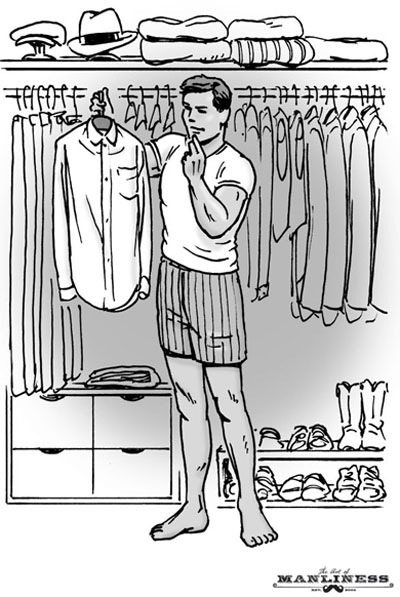
For the man with an unlimited budget, style is easy. The rest of us have to work a little harder to look good with the cash we have.
A key wardrobe concept for any man is interchangeability.
It sounds complicated and tedious, but it’s a very simple idea.
An interchangeable wardrobe is one with fewer specific pieces, but many possible clothing combinations.
That is to say, each piece you purchase works with the maximum number of other pieces, allowing you to mix and match in a variety of ways.
Building an interchangeable wardrobe isn’t a one-time project. You don’t just go out and buy one at the store. So treat this as a long-term goal, and in fact almost a mindset, rather than a quick fix for your look!
Work With What You Have – Check Your Current Closet
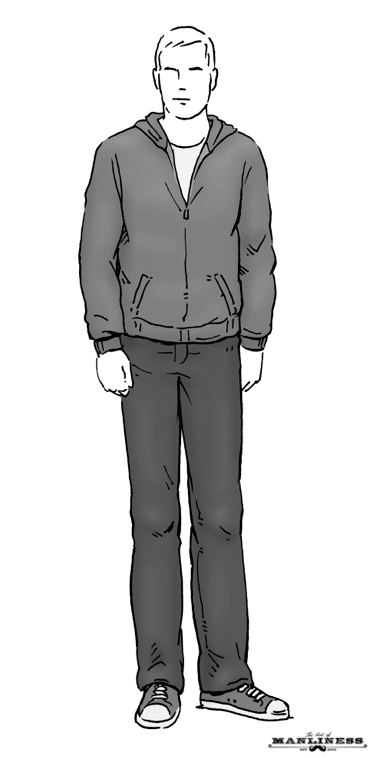
Take an honest inventory of your existing style.
Look through your drawers and your closet and see what you have to work with, including the old pieces that you haven’t worn in a while. Some of those might be surprisingly easy to repurpose while others are destined for the thrift store or the trash heap.
Do a realistic assessment and adjust your existing wardrobe as needed:
- Throw out the obvious losers. Anything that doesn’t fit (and can’t be adjusted to fit) needs to go, not just to the back of the closet but to the trash or a thrift store, so that you won’t be tempted to try to include it in an outfit someday. “What was I thinking?” pieces that you can’t bring yourself to wear with anything else in your wardrobe can probably also go — don’t fall for a “sunken costs” fallacy by wearing a bad style just because you bought it and it’s still in useable shape.
- Pull anything that needs repairs or adjustments while you’re looking through your options. Make a pile and get it seen to — that way you take care of all of the “I should have someone fix that some day” tailoring jobs in one go. To be interchangeable, clothes have to be in decent repair. A frayed hem doesn’t go with anything!
- Think about repurposed styles. Maybe you don’t wear an old suit anymore because the pants don’t fit — but if the jacket still fits, see if you can dress it down with jeans for an urban-casual look. A lot of pieces can have a second life as a funky accent once they’ve served their time as a wardrobe staple.
Be thinking about the common themes that tie your wardrobe together as you do this. Are there a lot of work clothes? Business dress items? Sports jackets?
The items and styles that you have a lot of will determine, to some extent, what you should be shopping for in the future. If the only shirts you own are T-shirts and flannel work shirts, for example, there’s no sense in running out and buying sharkskin wool slacks — they don’t go with any of your shirts.
In a case like that, a man would need to buy shirts to bridge the gap between his current wardrobe and his desired wardobe. Someone who’s starting with nothing but jeans and T-shirts, for example, can branch out into casual dress shirts that go with jeans — but that will also look fine with nicer trousers, should he choose to add them at some point.
Pick Your “Core” Items
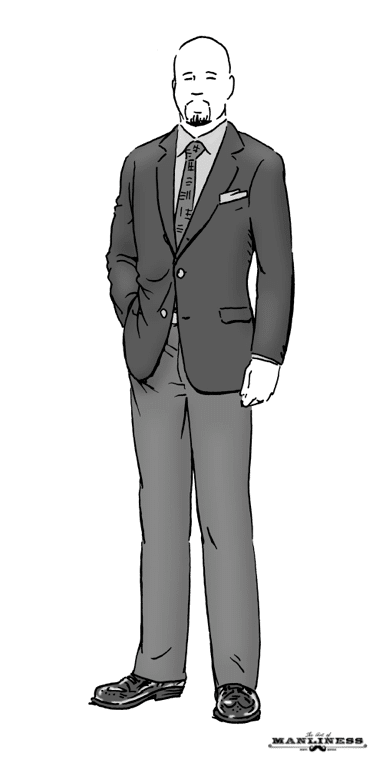
An interchangeable wardrobe is a lot easier to build when you’ve got a half-dozen to a dozen basic staple pieces that go with everything.
These aren’t necessarily exciting on their own, but they make you look good, and they serve as a neutral framework for more unique accent pieces.
Everyone’s core items are going to be a little different. That’ll be a part of defining your own personal style. But here are a few can’t-go-wrong staples that just about every man should consider owning for purposes of interchangeability:
- A dark suit, navy or charcoal. I can’t think of a reason why any successful man shouldn’t own at least one well-fitted, timelessly classic suit.
- A really solid pair of jeans. Sturdy, simple, and dark, with a nice close (but not tapered) fit.
- A sport jacket made from a fabric that does not look like it comes from a suit. Brown, blue, olive, tan — in muted patterns are all options. Practice wearing it – you’ll learn to love what it does for your confidence and how it affects the attitude of others.
- Five solid or small-patterned light-colored dress shirts (white and light blues). You could wear it with a suit for the most formal business setting imaginable, or you could wear it with jeans on a cattle ranch. It’ll work for pretty much everything in between, too. Now that’s versatility.
- A lightweight, conservative (grey, navy, olive), solid-colored sweater. The quintessential layering item. Goes with everything. See what we mean about sweaters here.
- At least two pairs of dress pants. Grey flannel, tan, medium-grey worsted wool, or khaki. A pair of well-fitted chinos or cords is a third option – but these are more casual, so make sure they suit your needs.
- Two pairs of casual shoes. Pick your style (brogues, work shoes, dress boots, loafers, saddle shoes, etc.), but have ’em. This is how you dress up jeans, or dress down nicer outfits. Click here for a refresher on footwear.
Are you getting the idea of interchangeability? Simple, sturdy, and functional are your key words here — styles and qualities that’ll last you for years.
Not everything has to be as plain as Amish country, mind you, even in the core wardrobe. Your “plain white dress shirt” can realistically be something with a light stripe or check pattern instead, if you prefer. It won’t serve for ultra-formal business dress, but it’ll do for everything else, and look a little more interesting in casual outfits.
Price can also be kept under control by thrifting or asking family for gifts/gently used items. I know men who have assembled all the above for less than $100. Read more about how to build a wardrobe inexpensively.
The goal is to build your core around things that will play nice with others, not to eliminate all uniqueness from your wardrobe staples.
The end result?
- 2 pairs of shoes
- 3 trousers
- 5 shirts
- 2 jackets (we’ll double that navy suit as a blazer)
2 X 3 X 5 X 2 = 60 unique outfits from a simple wardrobe.
Add in neckties, pocket squares, the suit, and sweater…we could turn this into 300+ outfits.
Expand the Core
There’s a difference between adding to your wardrobe and expanding it.
Expanding means you’re actually pushing the boundaries a little — moving into new styles and areas where you weren’t already strong. That’s how you take the existing core and “interchange” it (the goal here is interchangeability, remember?) into new looks without leaving it completely behind.
If your entire wardrobe is based on jeans and casual shirts, for example, you should be looking at things like sports jackets and blazers that can be worn with blue jeans. Once you have those, you’ll rapidly discover that they can be worn with nicer slacks as well — making those your next likely expansion. And so on.
It works both ways on the scale of formality, too — a guy with a high-paying job and a sharp wardrobe of suits, wool slacks, and crisp blazers can benefit by adding some casual trousers and some softer sports jackets to give him access to a more relaxed style.
Think of it as a game of leapfrog. Each new item should provide a springboard to new options, but it should work with the clothes you already have, too.
Create Uniqueness with Accent Pieces
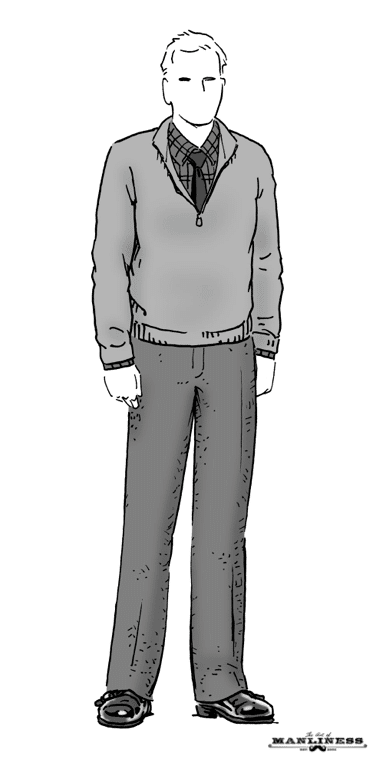
Let’s think about a completely neutral, ordinary outfit for a casual man: dark, fitted jeans and a white (or lightly patterned) dress shirt tucked in.
Generic, right?
But no man’s going to leave the house wearing just those two items. He’s also got his shoes and belt to pick, possibly a jacket, as well as any jewelry he wears (and hopefully undergarments of some kind).
Turns out those choices make a lot of difference. The same jeans and shirt are going to look very different paired with a broad brown belt and brown tooled-leather western boots than they would with black brogues, a slim black dress belt with a silver buckle, and a silver watch.
One outfit is rugged and “country,” the other is sleek and urban. That’s the power of accent pieces.
Use your choice of accents to turn your core wardrobe into a true personal style. Traditional accent pieces that you can play around with include:
- Neckties (smooth, knit, bow, etc.)
- Pocket squares (worn with any kind of sport/blazer/suit jacket)
- Jewelry (wristwatches, tie clips/chains, rings, cufflinks, etc.)
- Belts (plain, braided or stamped leather, cloth, decorative buckles, etc.)
- Shoes (dress and casual leather, canvas, boots, etc.)
- Outerwear (coats, hats, gloves, etc.)
These will be your primary tools for turning basic core items into a fully-functional wardrobe that expresses your personal style.
That said, there’s also room in everyone’s wardrobe for larger pieces that are too eye-grabbing or unique to really be “core” pieces. A pair of brightly-colored corduroys, for example, aren’t nearly as versatile as a pair of khakis, but that doesn’t mean you shouldn’t ever wear them. Just treat them as an accent, and pair them with some neutral core pieces so the whole outfit doesn’t get too overwhelming.
Most of your outfits will consist of a couple core pieces and a couple accent pieces. The more accents you add, the more unique the outfit gets. Learning not to overdo it is a valuable skill — if you’ve bought good core pieces, you don’t need to go overboard layering on top of them!
Invest in Quality
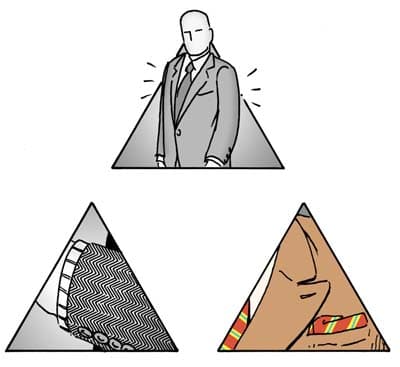
Fit – Fabric – Style – The Style Pyramid
One of the most important wardrobe-building skills is knowing when to say “no.”
A single good piece of clothing that works with almost everything in your closet is worth more than two or three single-use items that you can only work into one or two outfits.
Focus on the style pyramid when you shop: the three priorities of fit, fabric, and style.
- Fit is the most important characteristic of your clothing. If a piece doesn’t fit properly — comfortably close but not over-tight, with no pinching or sagging — it’s not going to make you look good, and it won’t work with the rest of your wardrobe. Only buy pieces that fit well, or that can be easily adjusted by a tailor.
- Fabric the weight and thickness of the cloth matters! A smooth, heavy fabric will drape more naturally than a thin, cheap one. You also want to look for quality construction — there’s no sense in buying something that’s going to come apart at the seams in a year or two.
- Style is your personal judgment of how well the piece in question will fit with the rest of your wardrobe. Don’t be afraid to add the occasional outlier or experiment — but make sure most of the things you’re purchasing are interchangeable with your core items.
Turn things down if they don’t pass all three of these tests. You want to be satisfied with the fit, the fabric, and the style. Something that suits your aesthetic tastes but doesn’t fit right, or isn’t made to your satisfaction, won’t ever become a good wardrobe addition. You’re better off holding out for something better.
How to Test Interchangeability

This all might sound great in theory, but how does an interchangeable wardrobe work in practice?
Try this: pick a piece out of your wardrobe. Any core piece will do — a shirt, a jacket, a pair of trousers.
Now, think about another type of item that you wear with that piece. So if you’re looking at a shirt, think about jackets you might wear over it.
Do at least half of your options match? (So in the example of a shirt, do half your jackets go with it?)
If the answer is “no” — if there are really only one or two items that go with the piece you’re thinking about — it’s not that flexible.
That doesn’t mean you should throw a piece out, but it does mean it’s probably not a reliable core wardrobe staple. Use it as more of a statement piece, jazzing up otherwise neutral outfits from time to time.
Overall, you’re shooting for a wardrobe that’s about “half working with half” — in other words, about half your options should be neutral enough that any one of them would work with half the wardrobe.
If you can achieve that — and can slowly build a good collection of accents that speak to your own personal style — you’ll have interchangeability mastered.
Watch a Video Summary of This Post
_______________________________________
Written By:
Antonio Centeno
Founder of Real Men Real Style
Creator of The Style System – a college-level course that teaches the foundations of professional dressing so you control the message your image sends.


